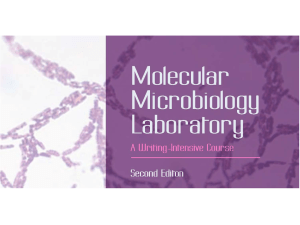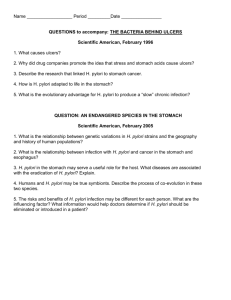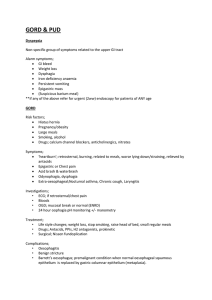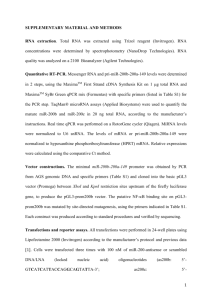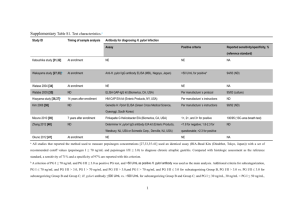Document 13309045
advertisement
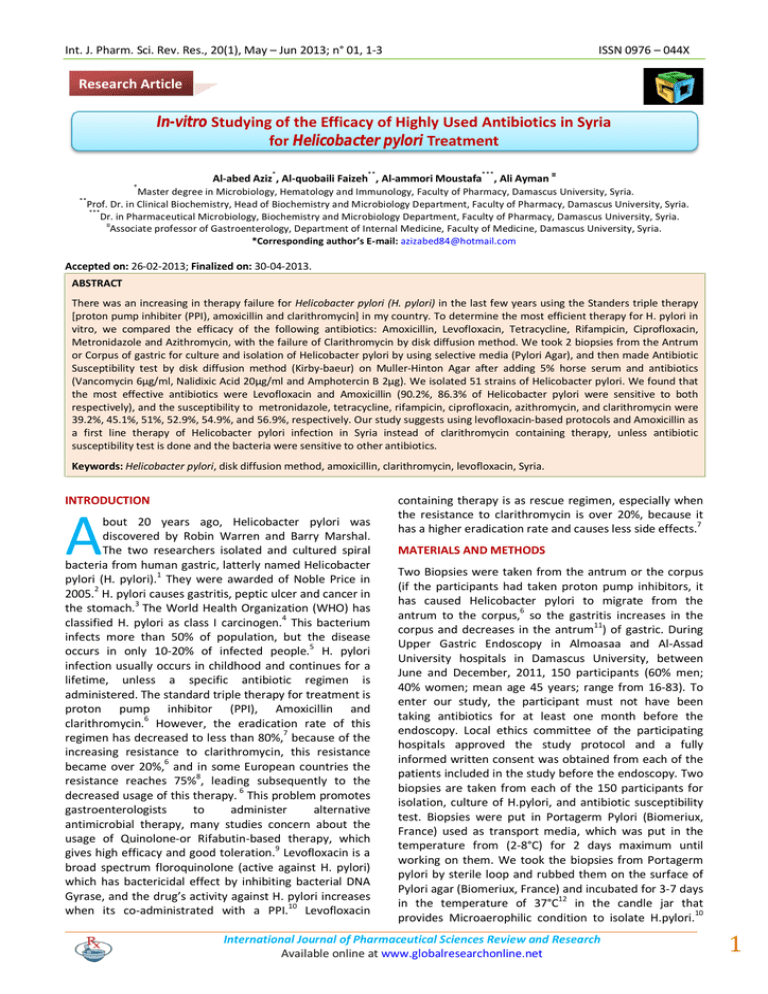
Int. J. Pharm. Sci. Rev. Res., 20(1), May – Jun 2013; n° 01, 1-3 ISSN 0976 – 044X Research Article In-vitro Studying of the Efficacy of Highly Used Antibiotics in Syria for Helicobacter pylori Treatment ٭ ٭ ٭٭ ٭٭٭ Al-abed Aziz , Al-quobaili Faizeh , Al-ammori Moustafa , Ali Ayman ¤ Master degree in Microbiology, Hematology and Immunology, Faculty of Pharmacy, Damascus University, Syria. Prof. Dr. in Clinical Biochemistry, Head of Biochemistry and Microbiology Department, Faculty of Pharmacy, Damascus University, Syria. ٭٭٭ Dr. in Pharmaceutical Microbiology, Biochemistry and Microbiology Department, Faculty of Pharmacy, Damascus University, Syria. ¤ Associate professor of Gastroenterology, Department of Internal Medicine, Faculty of Medicine, Damascus University, Syria. *Corresponding author’s E-mail: azizabed84@hotmail.com ٭٭ Accepted on: 26-02-2013; Finalized on: 30-04-2013. ABSTRACT There was an increasing in therapy failure for Helicobacter pylori (H. pylori) in the last few years using the Standers triple therapy [proton pump inhibiter (PPI), amoxicillin and clarithromycin] in my country. To determine the most efficient therapy for H. pylori in vitro, we compared the efficacy of the following antibiotics: Amoxicillin, Levofloxacin, Tetracycline, Rifampicin, Ciprofloxacin, Metronidazole and Azithromycin, with the failure of Clarithromycin by disk diffusion method. We took 2 biopsies from the Antrum or Corpus of gastric for culture and isolation of Helicobacter pylori by using selective media (Pylori Agar), and then made Antibiotic Susceptibility test by disk diffusion method (Kirby-baeur) on Muller-Hinton Agar after adding 5% horse serum and antibiotics (Vancomycin 6µg/ml, Nalidixic Acid 20µg/ml and Amphotercin B 2µg). We isolated 51 strains of Helicobacter pylori. We found that the most effective antibiotics were Levofloxacin and Amoxicillin (90.2%, 86.3% of Helicobacter pylori were sensitive to both respectively), and the susceptibility to metronidazole, tetracycline, rifampicin, ciprofloxacin, azithromycin, and clarithromycin were 39.2%, 45.1%, 51%, 52.9%, 54.9%, and 56.9%, respectively. Our study suggests using levofloxacin-based protocols and Amoxicillin as a first line therapy of Helicobacter pylori infection in Syria instead of clarithromycin containing therapy, unless antibiotic susceptibility test is done and the bacteria were sensitive to other antibiotics. Keywords: Helicobacter pylori, disk diffusion method, amoxicillin, clarithromycin, levofloxacin, Syria. INTRODUCTION A bout 20 years ago, Helicobacter pylori was discovered by Robin Warren and Barry Marshal. The two researchers isolated and cultured spiral bacteria from human gastric, latterly named Helicobacter pylori (H. pylori).1 They were awarded of Noble Price in 2005.2 H. pylori causes gastritis, peptic ulcer and cancer in the stomach.3 The World Health Organization (WHO) has classified H. pylori as class I carcinogen.4 This bacterium infects more than 50% of population, but the disease 5 occurs in only 10-20% of infected people. H. pylori infection usually occurs in childhood and continues for a lifetime, unless a specific antibiotic regimen is administered. The standard triple therapy for treatment is proton pump inhibitor (PPI), Amoxicillin and clarithromycin.6 However, the eradication rate of this regimen has decreased to less than 80%,7 because of the increasing resistance to clarithromycin, this resistance became over 20%,6 and in some European countries the 8 resistance reaches 75% , leading subsequently to the 6 decreased usage of this therapy. This problem promotes gastroenterologists to administer alternative antimicrobial therapy, many studies concern about the usage of Quinolone-or Rifabutin-based therapy, which 9 gives high efficacy and good toleration. Levofloxacin is a broad spectrum floroquinolone (active against H. pylori) which has bactericidal effect by inhibiting bacterial DNA Gyrase, and the drug’s activity against H. pylori increases 10 when its co-administrated with a PPI. Levofloxacin containing therapy is as rescue regimen, especially when the resistance to clarithromycin is over 20%, because it has a higher eradication rate and causes less side effects.7 MATERIALS AND METHODS Two Biopsies were taken from the antrum or the corpus (if the participants had taken proton pump inhibitors, it has caused Helicobacter pylori to migrate from the antrum to the corpus,6 so the gastritis increases in the corpus and decreases in the antrum11) of gastric. During Upper Gastric Endoscopy in Almoasaa and Al-Assad University hospitals in Damascus University, between June and December, 2011, 150 participants (60% men; 40% women; mean age 45 years; range from 16-83). To enter our study, the participant must not have been taking antibiotics for at least one month before the endoscopy. Local ethics committee of the participating hospitals approved the study protocol and a fully informed written consent was obtained from each of the patients included in the study before the endoscopy. Two biopsies are taken from each of the 150 participants for isolation, culture of H.pylori, and antibiotic susceptibility test. Biopsies were put in Portagerm Pylori (Biomeriux, France) used as transport media, which was put in the temperature from (2-8°C) for 2 days maximum until working on them. We took the biopsies from Portagerm pylori by sterile loop and rubbed them on the surface of Pylori agar (Biomeriux, France) and incubated for 3-7 days in the temperature of 37°C12 in the candle jar that provides Microaerophilic condition to isolate H.pylori.10 International Journal of Pharmaceutical Sciences Review and Research Available online at www.globalresearchonline.net 1 Int. J. Pharm. Sci. Rev. Res., 20(1), May – Jun 2013; n° 01, 1-3 We started watching the growth after 2 days, and we considered the growth is positive if one or more small, gray colonies have appeared.13 We obtained 51 strains, and we carried out the Gram stain, Catalase test and Oxidase test, to identify and confirm H. pylori. We used the Brain Heart infusion (Abtek, UK) slant agar (BHIA) after adding 5% horse serum,14 and antibiotics which were vancomycin 6µg/ml, amphotercin B 20µg/ml, and nalidixic Acid 20µg/ml, (VAN)15 to store the strains. We took a colony from H. pylori that grew on Pylori agar by sterile loop and cultured in a zekzak way on the surface of BHIA and incubated for 38 hours in a temperature of 37°C in the candle jar, after seeing the growth of H. pylori we kept them in the refrigerator as a source of bacteria.16 We took colonies from BHIA by sterile loop and cultured them in nutrient broth agar with 5% horse serum and incubated for 18-20 hours in the temperature of 37°C in the candle jar. Then we got a bacterial suspension with a density equivalent to a McFarland number 4 standard (12 ×108 colony forming units/ml). After making 3 dilutions we added the suspension to Petri dishes that contain Muller Hinton agar (Abtek, UK) after adding 5% horse serum, and VAN, after that we put the antibiotic disks: amoxicillin (Amx,25µ), clarithromycin (clm, 15 µ), azithromycin (azm, 15µ), tetracycline (tet, 30 µ), metronidazole (mtz, 5 µ), levofloxacin (Lev, 5 µ), ciprofloxacin (cpr, 5 µ), rifampicin ISSN 0976 – 044X (Rif, 30µ), according to Kirby-baeur method (disk diffusion method) and we returned the Petri to the candle jar and incubated it for 24 hours in the temperature of 37°C. RESULTS Biopsies were cultured in pylori agar from all 150 participants. A total of 56 (37.3%) were positive, and 94 (62.7%) negative by culture. After measuring inhibition zone of 51 bacteria (5 bacteria died), the results were: H. pylori had very high resistance to 6 out of 8 antibiotics; higher resistance was to tetracycline (39.2%), metronidazole (45.1%), rifampicin (51.0%), ciprofloxacin (52.9%), azithromycin (54.9%), and then clarithromycin (56.9%). There were two antibiotics levofloxacin and Amoxicillin, that H. pylori were very sensitive to, the sensitivities were 90.2% and 86.3%, respectively. There were 2 antibiotics, azithromycin and tetracycline, that H. pylori were intermediate to them, as table (1) is presented the result. H. pylori that’s sensitive to amoxicillin and clarithromycin (most common used combination) were only 26 (51%), it is very low especially that we had 18 (35.3%) of H. pylori sensitive to amoxicillin but resistant to clarithromycin. For new treatment that contains levofloxacin and amoxicillin, the sensitivity of H. pylori to both antibiotics were very high 43 (84.3%). Table 1: H. pylori sensitivity to the antibiotics used in our study Number of bacteria Antibiotics R ° ٭ I S ¤ Percentage Total R ° ٭ I S¤ Total Amoxicillin 7 0 44 51 13.7% 0% 86.3% 100 Levofloxacin 5 0 46 51 9.8% 0% 90.2% 100 Clarithromycin 22 0 29 51 43.1% 0% 56.9% 100 Azithromycin 21 2 28 51 41.2% 3.9% 54.9% 100 Tetracycline 26 2 23 51 51.0% 3.9% 45.1% 100 Rifamycin 25 0 26 51 49.0% 0% 51.0% 100 Metronidazole 31 0 20 51 60.8% 0% 39.2% 100 Ciprofloxacin 24 0 27 51 47.1% 0% 52.9% 100 ¤ ٭ R°: resistance, I: intermediate, S: sensitive DISCUSSION AND CONCLUSION Levofloxacin was the most effective, 90.2% of isolated H. pylori were sensitive to it. That is because of the little use of this antibiotic in Syria. Almost the same result was reported in Carothers et al study in USA, where 91.2% of 17 H. pylori were found to be sensitive to levofloxacin. Amoxicillin was effective in comparison with other antibiotics which were used in our study, 86.3% of H. pylori were sensitive to it, but comparing to other studies 9 such as Wueppenhorst et al. study , in Germany, and Kim 18 et al. study , in Korea, there were no isolated H. pylori resistant to Amoxicillin, this difference in result is belonged to the random use of Amoxicillin in our country. H. pylori isolates demonstrated sensitivity less than 80% against antibiotics, rendering them ineffective in eradication therapy7, so all other antibiotics appeared to be ineffective in therapy because of their sensitivity which was less than 80%. The sensitivity of H. pylori to metronidazole, tetracycline, rifampicin, ciprofloxacin, azithromycin, and clarithromycin was 39.2%, 45.1%, 51%, 52.9%, 54.9%, and 56.9%, respectively. The high resistance to metronidazole could partially be explained by its excessive use in some parasite and anaerobic infections in Syria. For tetracycline, high resistance could partially be attributed to the frequent prescription for acne and non-gonococcal urethritis19. For Syrian physicians, ciprofloxacin is prescribed as the first choice to treat urinary tract infection, hence the high resistance International Journal of Pharmaceutical Sciences Review and Research Available online at www.globalresearchonline.net 2 Int. J. Pharm. Sci. Rev. Res., 20(1), May – Jun 2013; n° 01, 1-3 reported in this study. For azithromycin and clarithromycin, high resistance could partially be attributed to the frequent prescription for respiratory infections, and cross resistance. Most common therapy to H. pylori in Syria is standard triple therapy which contains clarithromycin, amoxicillin, and PPI, and we have noticed from our study that only 26 (51%) of H. pylori were sensitive to both antibiotics, which is very low in comparing with levofloxacin and amoxicillin, where H. pylori were sensitive to 43 (84.3%) of both. Recommendation and Suggestion We are advised to replace clarithromycin levofloxacin in H. pylori infection therapy. with REFERENCES 1. Kusters, J.G., van Vliet, A.H.M., and Kuipers, E.J., Pathogenesis of Helicobacter pylori infection. Clinical Microbiology, 19, 2006, 449- 490. 2. Marshall, B. and Adams, P.C., Helicobacter pylori: A Nobel pursuit? Canadian Journal of Gastroenterology, 22, 2008, 895-896. 3. Carpenter, B.M., Gancz, H., Benoit, S., Evans, S., Olsen, C., Michel, S., Maier, R., Merrell, D., Mutagenesis of conserved amino acid of helicobacter pylori Fur reveals resideus important of function. Journal of bacteriology, 192, 2010, 5037-5052. 4. Toledo, H. and pez-Solıs, R.L., Tetracyclin resistance in childreen clinical isolate of helicobacter pylori. jouranl of antimicrobial chemotherapy, 65, 2010, 470-473. 5. Chu, Y.-T., Wang, Y., Wu, J., Lei, H.,Invasive and Multiplicationof Helicobacter Pylori in Gastric Epithelum Cells And Implication For Antibiotic Resistance. Journal of american sociaty of microbiology infection and immunity, 78, 2010, 4157-4165. 6. Malfertheiner, P., Megraud, F., O’Morain, C., Atherton, J., Axon, A., Bazzoli, F., Gensini, G., Gisbert, J., Graham, D., Rokkas, T., El-Omar, E., Kuipers, E., Management of Helicobacter pylori infection the Maastricht IV/ Florence Consensus Report. British medical journal, 16, 2010, 646664. 7. Chuah, S.-K.,Woei, F., Hsu, T., Wu, D.A new look at antiHelicobacter pylori therapy. World Journal of Gastroenterology, 17, 2011, 3971-3975. 8. Gumurdulu, Y., Serin, E., Ozer, B., Kayaselcuk, F., Ozsahin, K., Cosar, A. M., Gursoy, M., Gur, G., Yilmaz, U., Boyacioglu, S.,Low eradication rate of Helicobacter pylori with triple 714 days and quadriple therapy in Turkey. World Journal of Gastroenterol, 10, 2004, 668-671. ISSN 0976 – 044X 9. Wueppenhorst, N., Stueger, H., Kist, M., Glocker, E.,Identification and molecular characterization of tripleand quadruple-resistant Helicobacter pylori clinical isolates in Germany. Journal of Antimicrobial Chemotherapy, 63, 2009, 648-653. 10. Kuo, C.-H., Hu, H., Kuo, F., Hsu, P., Chen, A., Yu, F., Tsai, P., Wu, I., Wang, S., Li, C., Weng, B., Chang, L., Jan, C., Wang, W., Wu, D.,Efficacy of levofloxacin-based rescue therapy for Helicobacter pylori infection after standard triple therapy: a randomized controlled trial. Journal of Antimicrobial Chemotherapy, 63, 2009, 1017-1024. 11. Harris, A., Treatment of Helicobacter pylori. World Journal of Gastroenterology, 7, 2001, 303-307. 12. Sudhakar, U., Anusuya, C. N., Ramakrishnan, T., Vijayalakshmi, R.,Isolation of Helicobacter pylori from dental plaque: A microbiological study. Journal of Indian Sociaty of periodotology, 12, 2008, 67-72. 13. Vellozzi, E.M. and Giugliano, E.R., The Genus Helicobacter in Practical Handbook of Microbiology, E. Goldman and L. nd H.Green, 2 edition, Taylor & Francis Group, London, 2009, 579-602. 14. Garrido, L. and Toledo, H., Toledo, Novel genotypes in Helicobacter pylori involving domain V of the 23S rRNA gene. Helicobacter, 12, 2007, 505-509. 15. Salomaa-Ra¨sa¨nen, A., Kosunen, T. U., Mattila, J., Sarna, S., Rautelin H.,Age-Dependent Accuracy of Helicobacter pylori Antibody Assays for Adults, with Special Emphasis on Atrophic Gastritis. American Sociaty for Microbiology, 11, 2004, 1185-1188. 16. Degnan, A.J., Sonzogni, W. C., and Standridge, W.C.,Development of a Plating Medium for Selection of Helicobacter pylori from Water Samples. Applied and Enviromental Microbiology, 69, 2003, 2914-2918. 17. Wu, H., Shi, X. D., Wang, H. T., Liw, J. X.,The Relationship between Previous Fluoroquinolone Use and Levofloxacin Resistance in Helicobacter pylori Infection. jJournal of Clinical infectious Disease, 44, 2006, 5-8. 18. Kim, JM., Kim,JS., Jung, HC., Kim, N., and Song, IS., Antibiotic Resistance of Helicobacter pylori Isolated from Korean Patients in 2003. Korean Journal of Gastroenterology, 44(3), 2004, 126-135. 19. Wu, H., Shi, X. D., Wang, H. T., andLiw, J. X.,Resistance of Helicobacter pylori to metronidazole, tetracycline and amoxicillin. Journal of Antimicrobial Chemotherapy, 46, 2000, 121-123. Source of Support: Nil, Conflict of Interest: None. International Journal of Pharmaceutical Sciences Review and Research Available online at www.globalresearchonline.net 3
